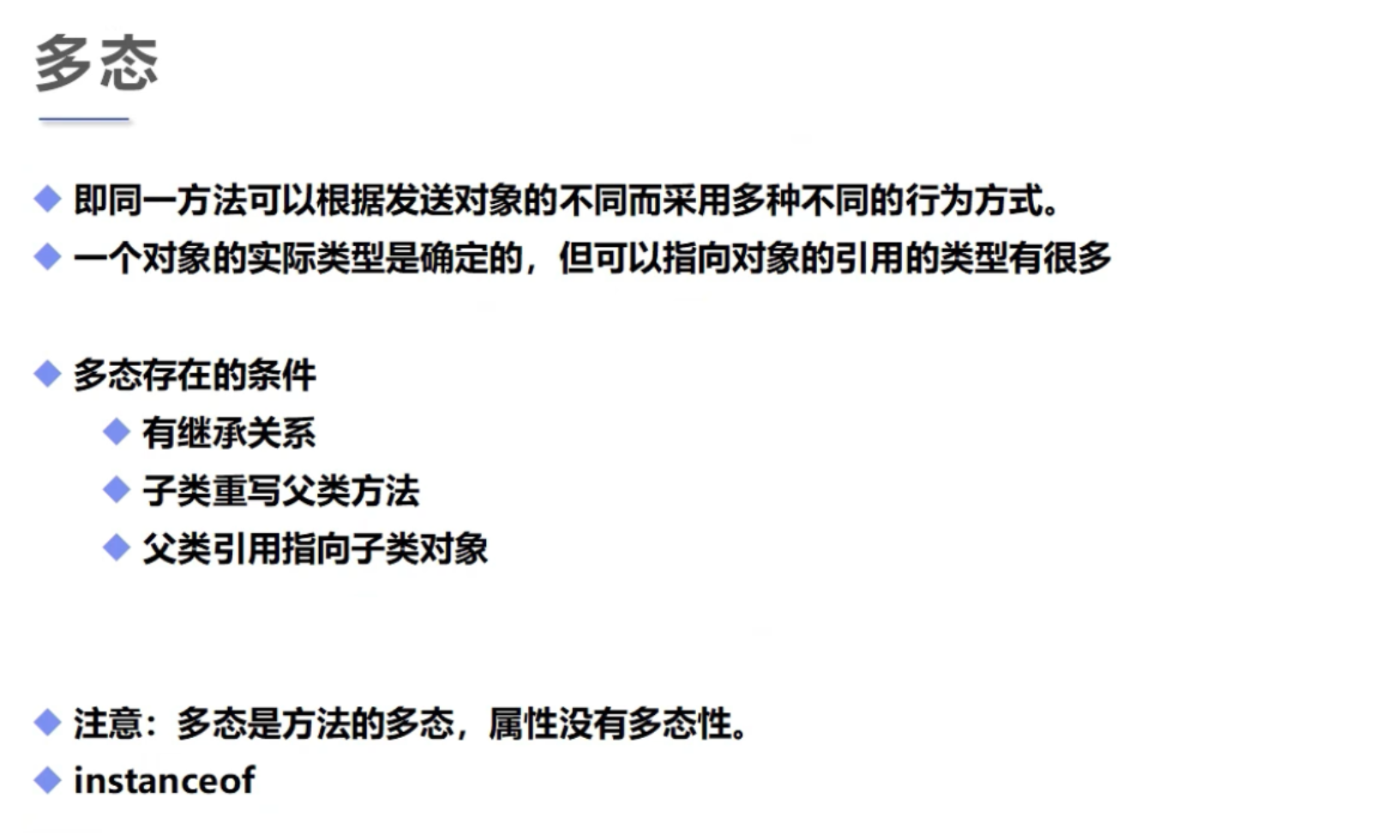
package com.oop;
import com.oop.demo06.Person;
import com.oop.demo06.Student;
public class Application {
public static void main(String[] args) {
//一个对象的实际类型是确定的
//new Person();
//new Student();
//可以指向的引用类型就不确定了 : 父类的引用指向子类
//Student 能调用的方法都是自己或者继承父类的!
Student s1 = new Student();
//Person 父类型,可以指向子类,但不能调用子类独有的方法!
Person s2 = new Student();
Object s3 = new Student();
s2.run();//子类重写了父类的方法,执行子类的方法
s1.run();
//对象能执行那些方法,主要看对象左边的数据类型,和右边关系不大!
//s2.eat();//Person没有eat()方法,引用失败
s1.eat();
((Student) s2).eat();
}
}
package com.oop.demo06;
public class Person {
public void run(){
System.out.println("run");
}
}
/*
多态注意事项:
1. 多态是方法的多态,属性没有多态
2. 父类和子类,有联系 类型转换异常! ClassCastException!
3. 存在条件:继承关系,方法需要重写,父类引用指向子类对象! Father f1 = new Son();
1. static 方法,属于类,它不属于实例
2. final 常量;
3. private 方法;
*/
package com.oop.demo06;
public class Student extends Person{
@Override
public void run() {
System.out.println("son");
}
public void eat(){
System.out.println("eat");
}
}
instanceof (类型转换) 引用类型,判断一个对象是什么类型,判断子父类之间的关系
package com.oop;
import com.oop.demo06.Person;
import com.oop.demo06.Student;
import com.oop.demo06.Teacher;
public class Application {
public static void main(String[] args) {
//Object > String
//Object > Person > Teacher
//Object > Person > Student
Object object = new Student();
//System.out.println(X instanceof Y); //能不能编译通过! X 与 Y 之间的关系
System.out.println(object instanceof Student); //true
System.out.println(object instanceof Person); //true
System.out.println(object instanceof Object); //true
System.out.println(object instanceof Teacher); //false
System.out.println(object instanceof String); //false
System.out.println("======================");
Person person = new Student();
System.out.println(person instanceof Student); //true
System.out.println(person instanceof Person); //true
System.out.println(person instanceof Object); //true
System.out.println(person instanceof Teacher); //false
//System.out.println(person instanceof String); //编译报错!
System.out.println("=======================");
Student student = new Student();
System.out.println(student instanceof Student); //true
System.out.println(student instanceof Person); //true
System.out.println(student instanceof Object); //true
//System.out.println(student instanceof Teacher); //编译报错!
//System.out.println(person instanceof String); //编译报错!
}
}
package com.oop.demo06;
public class Person {
}
package com.oop.demo06;
public class Student extends Person{
}
package com.oop.demo06;
public class Teacher extends Person {
}
package com.oop;
import com.oop.demo06.Person;
import com.oop.demo06.Student;
import com.oop.demo06.Teacher;
public class Application {
public static void main(String[] args) {
//类型之间的转换: 父 子
//高 低
Person obj = new Student();
//obj 将这个对象转换为Student类型,我们就可以使用Student类型的方法了!
//方式一
Student student = (Student) obj;
student.go();
//方式二
((Student) obj).go();
//子类转换为父类,可能丢失自己的本来的一些方法!
Teacher teacher = new Teacher();
teacher.to();
Person person = teacher;
//person.to(); //提示没有 to() 方法
}
}
/*
1. 父类引用指向子类的对象
2. 把子类转换为父类,向上转型
3. 把父类转换为子类,向下转型:强制转换
4. 方便方法的调用,减少重复的代码!简洁
封装、继承、多态! 抽象类、接口
*/
package com.oop.demo06;
public class Person {
public void run(){
System.out.println("run");
}
}
package com.oop.demo06;
public class Student extends Person{
public void go(){
System.out.println("go");
}
}
package com.oop.demo06;
public class Teacher extends Person {
public void to(){
System.out.println("to");
}
}